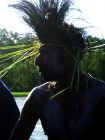 A plantation project in Papua has destroyed thousands of hectares of rainforest and decimated the traditional food sources of indigenous peoples, an investigation by The Gecko Project found. Indonesian government support for biomass project raises questions over the consistency of its climate change policies.
A plantation project in Papua has destroyed thousands of hectares of rainforest and decimated the traditional food sources of indigenous peoples, an investigation by The Gecko Project found. Indonesian government support for biomass project raises questions over the consistency of its climate change policies.
A timber plantation started to deforest pristine Papua forests more than a decade ago, but halted in 2014 because it wasn’t financially viable. It is now being revived by millions of dollars from two Indonesian government bodies whose mission is to support the country’s climate change commitments.
The Indonesian government committed to protect forests and to stop climate emissions from burning coal. However the second target is directly threatening forests, as the solution identified to use less coal is to burn increasing volumes of wood.
As a result, millions of dollars in 'green financing' intended to help Indonesia reduce its carbon emissions have been invested in a project that is destroying rainforest in Papua, one of the world’s most biodiverse landscapes. The money has been used to help an Indonesian conglomerate, Medco Group, construct a biomass power plant that is being fuelled by burning wood.
The project is devastating the ancestral territory of the Marind people, hunter-gatherers indigenous to the lowlands of Papua, in the far eastern reaches of Indonesia. Medco’s operations have damaged the Marind’s traditional food sources. Deforestation has made it significantly harder for them to source game.
Almost $4.5 million in financing for the power plant came from a state-owned company, which claims the power plant is helping to deliver on Indonesia's climate change commitments by generating renewable energy. But the area licensed to Medco includes large areas of “primary”, or intact, swamps and rainforests: landscapes Indonesia has committed to protect in order to curtail its vast carbon footprint.
Medco received further financing from a government fund that has been used to channel international support to help Indonesia reduce its greenhouse gas emissions by protecting rainforests.
Medco received further financing from a government fund that has been used to channel international support to help Indonesia reduce its greenhouse gas emissions by protecting rainforests.
“This is the reason we have opposed it from the beginning,” said Yuyun Indradi, director of Trend Asia, a nonprofit that monitors the government’s energy policies. “Indonesia’s biodiversity will be damaged by rapid development of monoculture tree plantations.”
Money from international donors has poured into Indonesia in recent years to help protect its forests and peatlands. In the past year alone, the UN Development Programme and Norwegian government have paid more than $100 million for that purpose into the Indonesian Environment Fund, or IEF – the same body that was used to finance Medco’s power plant in Papua.
Money from international donors has poured into Indonesia in recent years to help protect its forests and peatlands. In the past year alone, the UN Development Programme and Norwegian government have paid more than $100 million for that purpose into the Indonesian Environment Fund, or IEF – the same body that was used to finance Medco’s power plant in Papua.
In a stark illustration of the contradictions at the heart of Indonesia’s policies, that means the fund has been used to finance both forest conservation and a project predicated on deforestation.
Medco’s project started life in the late 2000s, as part of a major Indonesian government programme to convert large portions of southern Papua into a source of food and energy. The company’s initial plan was to plant a vast timber plantation that would produce wood chips for export.
Medco obtained a licence for some 170,000 hectares of land, overlapping substantially with the ancestral territory of indigenous Marind people living in a village named Zanegi. The Marind source game, fish and sago – their staple foods – from the forests and swamps north of Zanegi.
The village lies at the heart of the TransFly region, a landscape once described by the World Wide Fund for Nature as “the environmental jewel of the Asia-Pacific region.” It is a mosaic of wetlands, savannas and forests that is home to hundreds of bird species, including the iconic bird-of-paradise for which New Guinea is famous.
Medco obtained a licence for some 170,000 hectares of land, overlapping substantially with the ancestral territory of indigenous Marind people living in a village named Zanegi. The Marind source game, fish and sago – their staple foods – from the forests and swamps north of Zanegi.
The village lies at the heart of the TransFly region, a landscape once described by the World Wide Fund for Nature as “the environmental jewel of the Asia-Pacific region.” It is a mosaic of wetlands, savannas and forests that is home to hundreds of bird species, including the iconic bird-of-paradise for which New Guinea is famous.


